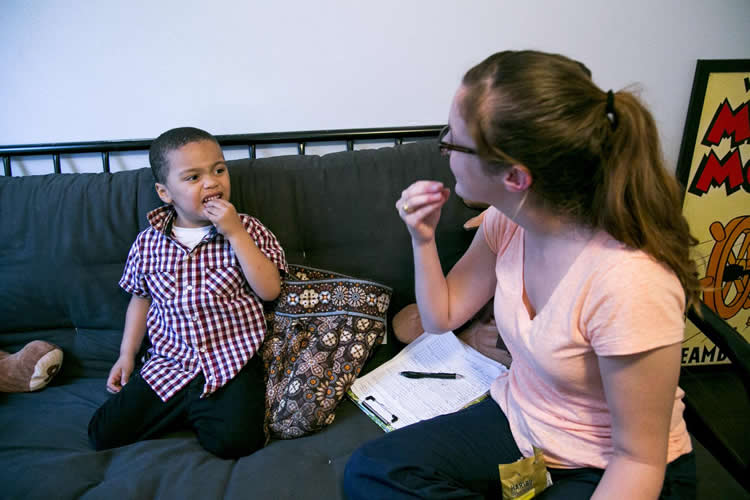Summary: A new study reports children with autism’s imitation behavior could help predict their development of flexible speech.
Source: University of Texas at Austin.
Nearly 30 percent of children with autism will not have learned to flexibly speak by the end of elementary school. For researchers looking for ways to help, learning when to intervene in the children’s speech development is paramount. New research from The University of Texas at Austin points to children with autism’s imitation behavior as the most important predictor of a key stage in their development toward flexible speech, which gives researchers more clarity about the timing of intervention.
Just before babies’ first words emerge, they begin to communicate with their caregivers by combining gestures and sounds. For example, a baby might look at her parent, point to a toy and make a sound to indicate that she wants it. Researchers refer to this behavior as “intentional communication.” Intentional communication predicts later language ability in children with autism spectrum disorder. But until now, the most important predictors of intentional communication were not known.
“Identifying those predictors provides us with an idea of what outcomes to target in early intervention to improve the likelihood that children with autism will learn to intentionally communicate, and then to speak,” said Micheal Sandbank, an assistant professor of special education at UT’s College of Education. “That early intervention can help substantially improve the long-term life and academic outcomes of children with autism.”
Sandbank recently conducted a study published in the Journal of Autism and Developmental Disorders that searched for the most important predictor of intentional communication. To do so, she used data from a larger multisite longitudinal study led by professors Paul J. Yoder and Linda Watson that took place at Vanderbilt University and the University of North Carolina-Chapel Hill.
Children in that study were between the ages of 2 and 4 when they entered, and they participated for 16 months. There was no intervention. Rather, they were brought in at study entry and every four months to participate in assessments that measured the development of their intentional communication, language and several other factors the researchers thought might predict their communication development over time.

Sandbank and her collaborators chose five behaviors that they thought might predict children’s intentional communication growth. These behaviors included the children’s ability to imitate actions, to play with objects and to follow a caregiver’s point or gaze with their eyes to see what the caregiver was talking about. These five factors also included two important things parents do: respond to their children’s play actions by physically playing with them or imitating them, and respond to their children’s play actions by talking about what their children are playing with.
“When we did the math, we were surprised to find that imitation was the most important predictor of intentional communication growth,” Sandbank said. “It means that the play-based methods that researchers have developed to help children learn to imitate communicative gestures may also help to put them on the path to speaking with success.”
Although imitation was determined to be the most important predictor, Sandbank noted that “this doesn’t mean that the other factors aren’t important.” Instead, it gives researchers a better understanding of the developmental sequence of intentional communication and perhaps the best way to target it.
Source: M. Yvonne Taylor – University of Texas at Austin
Image Source: NeuroscienceNews.com image is adapted from the University of Texas at Austin news release.
Original Research: Abstract for “Predicting Intentional Communication in Preverbal Preschoolers with Autism Spectrum Disorder” by Micheal Sandbank, Tiffany Woynaroski, Linda R. Watson, Elizabeth Gardner, Bahar Keçeli Kaysili, and Paul Yoder in Journal of Autism and Developmental Disorders. Published online March 4 2017 doi:10.1007/s10803-017-3052-1
[cbtabs][cbtab title=”MLA”]University of Texas at Austin “For Kids With Autism, Imitation Counts for More Than the Highest Form of Flattery.” NeuroscienceNews. NeuroscienceNews, 8 April 2017.
<https://neurosciencenews.com/autism-imitation-6368/>.[/cbtab][cbtab title=”APA”]University of Texas at Austin (2017, April 8). For Kids With Autism, Imitation Counts for More Than the Highest Form of Flattery. NeuroscienceNew. Retrieved April 8, 2017 from https://neurosciencenews.com/autism-imitation-6368/[/cbtab][cbtab title=”Chicago”]University of Texas at Austin “For Kids With Autism, Imitation Counts for More Than the Highest Form of Flattery.” https://neurosciencenews.com/autism-imitation-6368/ (accessed April 8, 2017).[/cbtab][/cbtabs]
Abstract
Predicting Intentional Communication in Preverbal Preschoolers with Autism Spectrum Disorder
Intentional communication has previously been identified as a value-added predictor of expressive language in preverbal preschoolers with autism spectrum disorder. In the present study, we sought to identify value-added predictors of intentional communication. Of five theoretically-motivated putative predictors of intentional communication measured early in the study (at study entry and 4 months after), three had significant zero-order correlations with later intentional communication (12 months after study entry) and were thus added to a linear model that predicted later intentional communication scores controlling for initial intentional communication scores at study entry. After controlling for initial intentional communication, early motor imitation was the only predictor that accounted for a significant amount of variance in children’s later intentional communication.
“Predicting Intentional Communication in Preverbal Preschoolers with Autism Spectrum Disorder” by Micheal Sandbank, Tiffany Woynaroski, Linda R. Watson, Elizabeth Gardner, Bahar Keçeli Kaysili, and Paul Yoder in Journal of Autism and Developmental Disorders. Published online March 4 2017 doi:10.1007/s10803-017-3052-1







